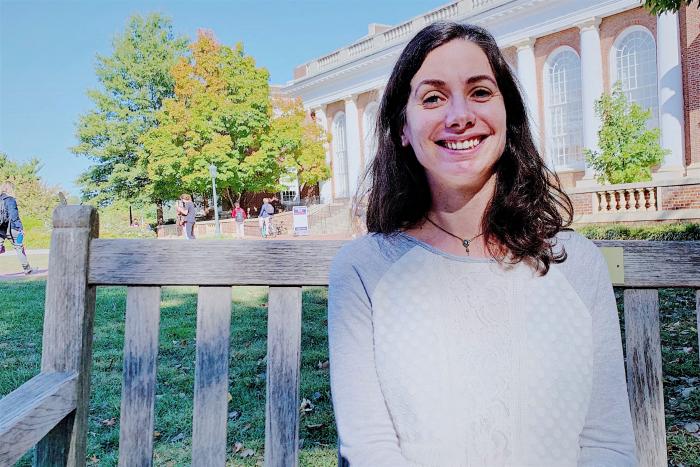Meet Susanna Klosko, IATH's New Project Manager

Meet Susanna Klosko, IATH's New Project Manager
This summer, the Institute for Advanced Technology in the Humanities, otherwise known as IATH, welcomed Susanna Klosko who began her service as the research unit’s project manager and designer this past June. Klosko joins IATH from the private sector having worked for the Afton-based tech startup Digital Relab. A Charlottesville native, Klosko earned her PhD in Near Eastern and Judaic Studies from Brandeis University where she completed her dissertation examining the lives and journeys of Russian Jewish émigrés to the United States who had their American citizenship questioned once they moved to Palestine.
Given her academic expertise in ancestry, it seemed logical that the website Ancestry.com offered Klosko entrée into digital historical methods. Upon completion of her doctorate, Klosko elected to build upon her long-standing, informal interest in computers by learning web development. She participated in an eight-month long boot camp, devoting twenty hours a week to learning JavaScript and Ruby on Rails. All of this took place while she worked at UVA Law’s Arthur J. Morris Law Library. There, she contributed to the development of “The Scottish Court of Session,” a digital archive that offers a sweeping view of life in the British Atlantic world in the eighteenth and nineteenth centuries as told through litigation documents submitted to Scotland’s supreme civil court. Once she completed the programming boot camp, she transitioned into the private sector but soon found that she wanted to be in an environment that made direct use of her doctoral training.
What follows is a Q&A with Klosko about her academic background, research interests, and what’s on her mind in the early days of her IATH tenure. Some responses have been edited for brevity and clarity.
Q&A with Susanna Klosko, IATH Project Manager and Designer:
Heiman: What makes IATH uniquely appealing to you as an experienced digital humanist?
Klosko: I wanted a job where it felt like I was able to use my PhD more fully. My dream to get involved with digital humanities projects and to work with faculty in a wide range of disciplines is exciting to me. I also really like the people at IATH. They’re very smart, on top of things, but also laid back and relaxed. They all have interesting and creative ideas about how to mix technology and humanities.
Heiman: What will your responsibilities as IATH project manager be and what are some of the key project management lessons and experiences that you’ll bring to this new role?
Klosko: I get to use programming languages like Ruby on Rails that I have a good amount of experience with, and I’m starting to jump in on a variety of projects all at different stages. For example, we’re in the midst of diagnosing a bug that affects The Scottish Court of Session project. IATH also has a partnership with the Digital Archaeological Archive of Comparative Slavery (DAACS), which has an affiliation with Monticello. It allows archaeologists from the American South to access archaeological artifacts. I spend most of my time on this project. Additionally, I’m working closely with IATH Fellows Luke Dahl in the McIntire Department of Music, Mona Kasra in Drama, and Edith Klaus in Slavic Languages and Literatures Department – all of whom work on projects utilizing IATH’s capabilities.
Heiman: Does your DH background – or do the humanities, period - prepare you in some way to be IATH’s Project Designer/Manager?
Klosko: My background as a historian allows me to recognize how technology can help present information in new ways. I plan to pursue research on behalf of IATH hopefully writing journal articles about digital humanities topics. There’s also the possibility of incorporating what I learn on the job into my personal research. For now, my main focus is getting up to speed on all of IATH’s projects. I think a web or social media presence could be good.
Heiman: What are your thoughts on digital preservation and the life cycle of DH projects?
Klosko: One thing that has come up is that we have 20-30 years of DH projects at UVA and a question everyone will have to face is how do you make sure this stuff doesn’t just vanish or disappear? How do you make sure these projects are still relevant? It’s a challenge that every DH practitioner must face but to my knowledge, it hasn’t deterred faculty from continuing to pursue digital projects.
Heiman: In a soundbite, how do you think DH approaches add value to humanistic inquiry writ large?
Klosko: I love the way DH allows you to aggregate information and draw these huge connections between seemingly unconnected events, words, or ideas. The IATH fellows we have this year are working on spatial representation of cultural heritage and it demonstrates the ability to use digital humanities to represent information in a novel format.
Heiman: Tell me more about your work with the Scottish Court of Session project.
Klosko: The Scottish Court of Session was a strongly historical research project looking at the development of Scottish law, society, and people and I was fascinated by the context of judges and advocates who were writing in the context of the Scottish enlightenment. The DH component of the project allowed me to see linkages between Scottish enlightenment philosophers and judges and advocates in the Scottish legal system.
Heiman: It’s been a pleasure to learn so much about your background and the important work ahead of you at IATH. Thank you for your time.
Klosko: Thank you.
